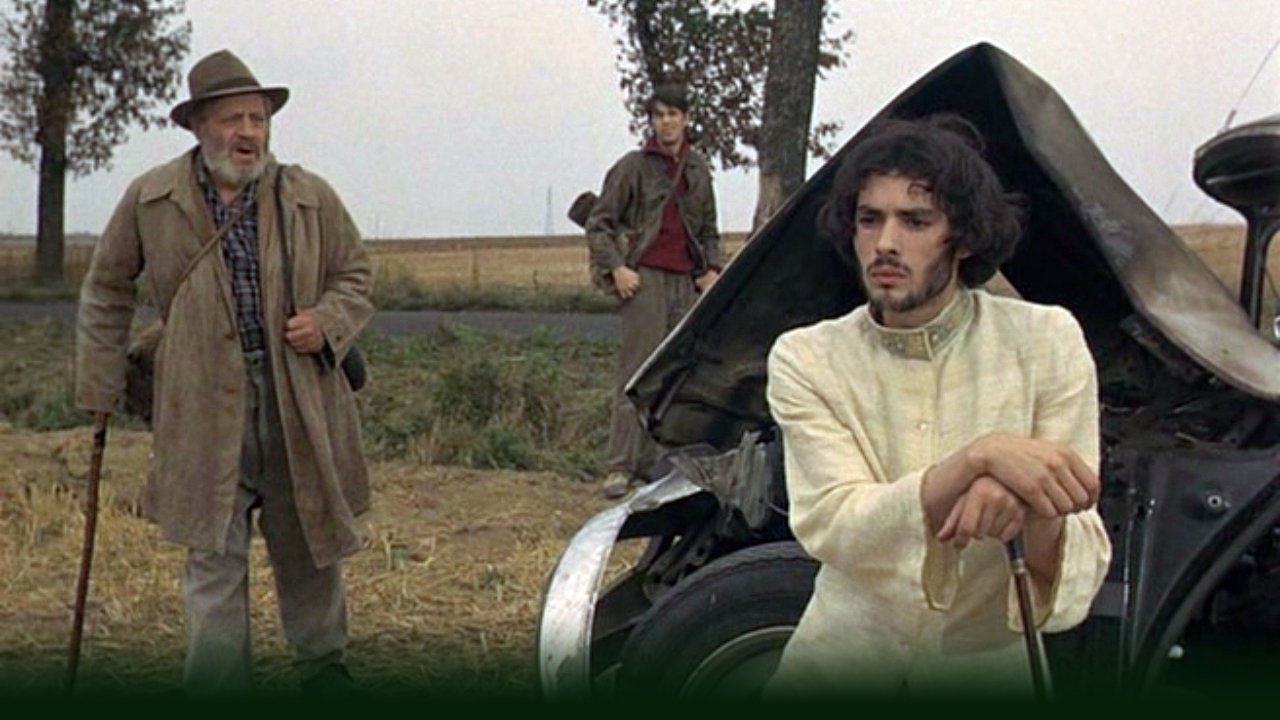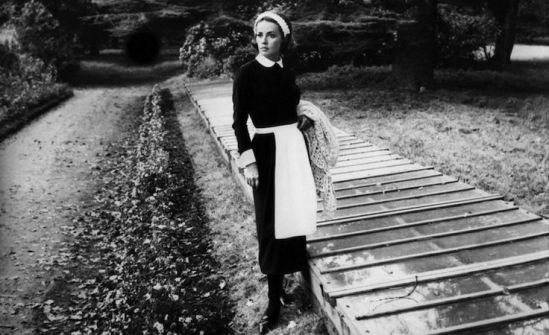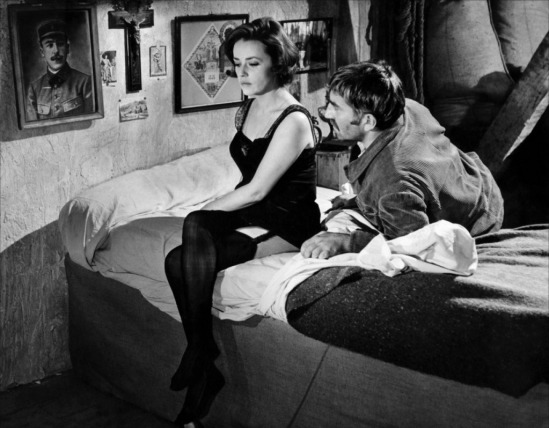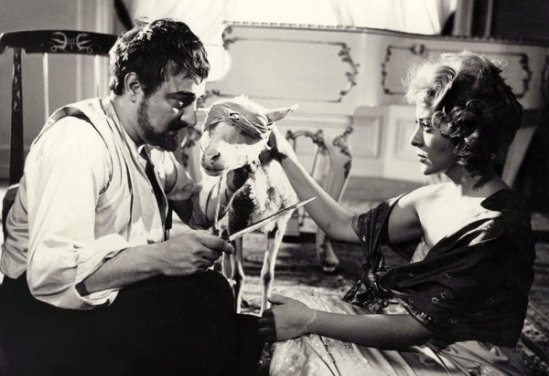In Nazarin (Mexico, 1959), Luis Buñuel would seem to be making the first of a series of black comedies concerning what would become a favorite target – Christianity. We’ve had hints and short episodes of this in many of his earlier films – the overtly surrealist L’Age D’Or took a number of Marquis de Sade-inspired swipes at the church, Susana’s reformatory escape seemed divinely arranged, and religious hypocrisy was one of the foundations of Francisco’s sterling reputation in El – This Strange Passion. Here our protagonist is Father Nazario (prolific Spanish actor Francisco Rabal), who leads a devout life of humility and anti-materialism. He has impoverished himself, living in a hostel teeming with poor laborers, grifters, and four particularly seedy streetwalkers. What few possessions he acquires are usually stolen from him shortly after, and he depends on the charity of others for his food – namely, his hard-boiled landlady Mrs. Chanfa (Ofelia Guilmáin) and her sullen helper Beatriz (Marga López). Beatriz would seem a perfect subject for Nazario’s spiritual ministrations – abandoned by her sneering boyfriend Pinto (Noé Murayama), she’s horribly depressed until she meets Nazario, who is unaware of Beatriz’ self-destructive nymphomania (illustrated in a fairly disturbing wish-fulfillment fantasy episode). Subsequently, Andara, one of the streetwalkers (Rita Macedo from …Archibaldo de la Cruz), is involved in a bloody and lethal quarrel with a rival prostitute, and hides from the police in Nazario’s room. The non-judgmental priest tends to her wounds while scolding her for her indiscretions, but it isn’t too long before the addled-but-still-manipulative Andara has Nazario fetching tequila for her. One of the prostitutes gets wind that Andara is holed up with Nazario, and Beatriz helps Andara to flee before the police arrive, but not before Andara sets fire to Nazario’s room as a distraction for the authorities. Accused of vile intimacies with the fugitive Andara, and alleged to be responsible for the fire that destroyed the entire hostel, Nazario will passively submit to the judgment of the authorities. But his fellow priest, Don Ángel (Edmundo Barbero) wants Nazario to spare himself (and the church) the humiliation that would follow, and Nazario decides to wander the countryside instead as a simple pilgrim.

Francisco Rabal in ‘Nazarin.’
credit: bnowalk.blogspot.com
Buñuel has no problem with the basics of Nazario’s beliefs. What he’s holding up is Nazario’s absolutism, and his willful disengagement from the culture that he’s part of, for better or worse. After Beatriz tries to convince Nazario that he has healed her sick niece (when the medicine the girl had taken the night before simply kicked in), Andara and Beatriz follow him into the ‘wilderness,’ seemingly enthusiastic acolytes. But in reality, Andara is simply another fugitive hanging on Nazario’s coattails, and Beatriz has channeled her own sexual torments into faux religious fervor. Nazario’s insistence on setting a Christian example as passively as possible becomes a kind of arrogance, and dark humor emerges from the missed opportunities, and disasters, that Nazario, unwittingly, leaves in his wake. Encountering a small construction crew, Nazario offers to work for food. But the other wage-earning workers dissuade him – his presence devalues their own jobs. As Nazarin walks away, we here a violent quarrel between the boss and his workers, and gunshots. Oh, well… The three travelers happen upon a small village racked with plague – everyone is dead or dying except for the clergy, who emerge from the chapel in full regalia – and Nazario counsels a dying woman to release herself from earthly concerns and think of heaven’s glory. Her response? “Juan…! Juan…!” Heaven can’t hope to compete with the glories of her boyfriend, and, when he actually shows up, they show our three pilgrims the door. Happening across a large, well-to-do family happily alighting from a horse-drawn carriage in a small village, Nazario shakes his head sadly – “There is nothing for us to do here.” Since they’re leading comfortable lives, Nazario sees them as irretrievable and/or unworthy.
Things come to a head in another rural village, when Andara becomes the love object of a browbeaten dwarf named Ujo, and Beatriz discovers that her former lover, Pinto, is here, buying horses. Pinto feeds the authorities stories of Nazario and Andara’s ‘perversions,’ and they’re arrested, while Pinto essentially kidnaps Beatriz as his sex slave (with her own mother’s help!). The local bishop has no problem with Nazario being hung – he just doesn’t want him perp-walking to the gallows with the other criminals (including Andara) in public. Like Don Ángel, the bishop has no conception of humanity’s true need for potential salvation outside his own absolutist beliefs and the preservation and promotion of the institution of the Church.
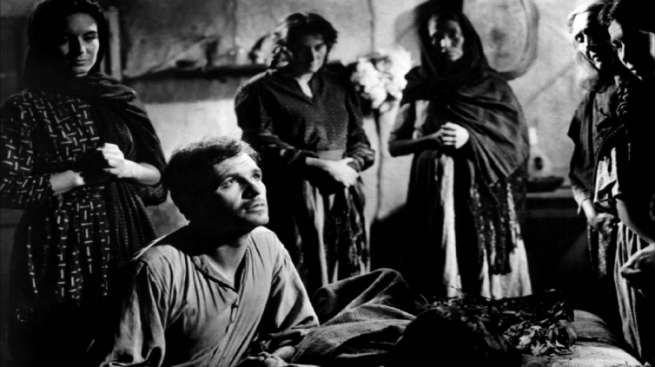
‘Nazarin.’
credit: thepinksmoke.com
Much of what Buñuel had learned by cranking out these Mexican dramas is on admirable display here. The film is yet another adaptation of someone else’s novel (Benito Pérez Galdós, who later wrote the book that Buñuel’s Tristana was based on as well), but the adaptation is thoroughly infused with Buñuel’s seamless visual narrative, scrupulous character detail and excoriating black humor. It’s almost hard to imagine this story being expressed by any other medium besides film, by any other author than Buñuel. The sympathy Buñuel expresses for Nazario, while simultaneously using him as the example of everything that’s wrong with everything he believes, is an astonishing balancing act, convincingly executed by the talented Rabal. And the varieties of behavior he elicits from Marga López and Rita Macedo are just as impressive – from earnest devotion to cackling psychosis, from realist intimacy to surrealist excess, they are the schizophrenic Magdalenes that unwittingly compel Nazario to pay any attention at all to the people around him, the appreciative permanent audience that Nazario thinks he’s refusing to play to. As mentioned before, Buñuel is fine with, or at least ambivalent about, the general moral and ethical myths and structures of Christianity. What makes religion malevolent, in his eyes, and in this masterful film, are the uses to which we sinners put it to.
Buñuel’s confidence in adapting literary properties to his own creative uses is also well-displayed in The Young One (La Joven) (Mexico, 1960), shot in Mexico with an American cast, in English. In this case, his collaborators are as interesting as the auteur; Buñuel’s credited co-writer is H.B. Addis, whom in reality was blacklisted American screenwriter Hugo Butler, who had moved to Mexico in 1951, and had previously collaborated with Buñuel on 1954’s Adventures Of Robinson Crusoe. The producer is credited as George P. Werker, but, again, this was a pseudonym for George Pepper, who had been an effective liberal activist until 1951, when Joe McCarthy’s House Un-American Activities Committee named him as a communist, and Pepper fled to Mexico rather than testify in what he knew would be a lose/lose forum. It was Pepper who had discovered Travelin’ Man, a provocative short story by Peter Matthiessen chronicling a fateful meeting between a black man, wrongfully accused of a crime he didn’t commit and an old-school white southern game warden, on an isolated island off the coast of Georgia. Pepper, Butler and Buñuel all admired the story, but took many constructive liberties to fashion a story of their own that enhanced and expanded Matthiessen’s, and Buñuel’s, central concerns.
Hap Miller (Zachary Scott) has been the game warden on this small island for quite a few years, assisted by Pee-Wee, an alcoholic handyman who, as the film starts, has just passed away, leaving a granddaughter, Evvie (Key Meersman), who had joined them a few years previously when her mother died. Now Miller is solely responsible for Evvie; at first, he wants to hand her over to the mainland church, and have them find a proper home for the young orphan. But Evvie, maturing, is also becoming a young woman, and Miller can’t help but consider keeping her around as a different kind of companion, despite the age difference and her reluctance to engage Miller intimately. The local boatman, Jackson (Crahan Denton), comes out on his regularly scheduled stop, and tells Miller that the local council has approved construction of a hunter’s clubhouse on the island, insuring that Miller will be set for quite a while under notably improved circumstances.

Key Meersman in ‘The Young One.’
credit: slantmagazine.com
But another ‘visitor’ has crossed over to Miller’s little fiefdom as well; this is Traver (Bernie Hamilton), a black jazz musician who resisted the attempts of one of the city women to seduce him, and whom subsequently cried “Rape!” against him in spiteful revenge. Fleeing the town in a small motorboat to avoid the impromptu necktie party, he lands on Miller’s island hoping to find food for himself and fuel for his boat. Miller has gone to the mainland to discuss the clubhouse and inquire to the church about Evvie, and in his absence Traver happens across Evvie. After a cautious initial confrontation, Evvie gives Traver some food and gas, and Traver avails himself of one of Miller’s shotguns as well, leaving Evvie with twenty dollars – he may be a fugitive, but he’s an honest one.
Miller returns the next day, and learns of Traver’s visit with Evvie. Furious that this colored fella would take so many insolent liberties (the “n” word is ubiquitous in the film), Miller charges off, rifle in hand, to protect what’s his and teach the intruder a lethal lesson. He blows holes in Traver’s small boat, and eventually fires at Traver himself. Thinking the man dead, Miller discovers Evvie kept the twenty dollars for herself, and Hap assumes it was payment for sexual favors. But the not-dead-yet Traver storms the cabin, holds Miller at bay while he picks up tools to repair the boat, and confirms Evvie’s story that the twenty dollars was honest payment for the things he needed. After leaving peacefully, Miller makes up with Evvie, and, to ingratiate himself further with her, pays a visit to Traver, who is repairing his boat on the beach. Still asserting his cultural superiority, Miller nonetheless learns that Traver shares his military experience – they both fought in Italy, nearly together. Miller eventually agrees to put Traver up while his boat’s patches cure, and recruits him to do a little work around the compound for the bed and food. Miller lets Traver stay in the separate cottage that Evvie’s been staying in, and takes Evvie into his own house for the night. Convinced that he’s back on Evvie’s good side, he finally has his way with the girl that night.
It’s pretty obvious to Traver what has happened, but he keeps his head down about it. Miller must now walk a fine line between his enmity for Traver, who is forthright about the inequalities that he must tolerate from people just like Miller, and parading his generosity towards Traver for Evvie’s sake. In a rainstorm that has stranded Traver at the compound for another night, Jackson appears – he has brought Reverend Fleetwood (Claudio Brook) to inquire about Evvie. Fleetwood’s arranged a place for her to stay in town, through the ladies’ auxiliary at the church. But Miller is no longer interested in giving Evvie up. Miller also learns from Jackson that Traver is a fugitive for the alleged rape of the socialite; Miller and Jackson, blitheringly ‘lawful’ as ever, go after Traver again, guns in hand, but he went into hiding when the boat showed up.
The next morning, after a fruitless night of ‘hunting,’ they resume the chase while the Reverend takes Evvie to one of the island lagoons to baptize her. Despite Evvie’s flustered surprise at what ‘baptism’ entails, she and the Reverend get along well, and, on the way back, it is they who happen upon Traver first. He’s been injured by an animal trap, and Evvie and the Reverend bring him back to Miller’s cottage to fix up his nasty wound. The Reverend expects to bring Traver back to the mainland to face the charges, believing Traver to be innocent, and hopeful that he’ll be acquitted. But Miller, and the virulently racist Jackson, may have other ideas.

Key Meersman and Zachary Scott in ‘The Young One.’
credit: cinesthesiac.blogspot.com
Buñuel’s concluding episodes of this expertly constructed crucible of southern class issues, racial tension, sordid sexuality and unlikely deliverance doesn’t have much in common with where Matthiessen took things originally. The original story exclusively concerned Traver and Miller. But our three collaborators spread the story out admirably, and created on of the most forthrightly disturbing and affecting films of the time. Vagaries of distribution, promotion, and marketing doomed the film to near-obscurity until Milestone Films released a new print of the film in 1993, and thoughtful reassessments by film critics and historians (most notably Chicago’s Jonathan Rosenbaum and Randall Conrad, writing in Cineaste) unearthed what may be one of Buñuel’s honest masterpieces, despite being a stylistic outlier from Buñuel’s other work. (Buñuel was obviously aware of this as well, but he couldn’t resist adding a quick moment of Evvie enthusiastically stepping on a large spider, recalling Gaston Modot hilariously doing the same in L’Age D’Or.) The script is superb, refusing to soften its more troubling subjects – Traver doesn’t deserve the fate he’s resisting in the film, yet we understand how commonplace circumstances like this were; describing them this baldly in 1960 might have been a marketing dealbreaker, and the film today is still considered by some to be an exploitative potboiler not unlike John Ford’s Tobacco Road or Russ Meyer’s Mudhoney. Evvie’s deflowering is equally repellent, and yet we never come to see Miller as a villain – Zachary Scott’s performance, loud, flinty and indignant, is nonetheless filled with small details and choices that keep him genuinely human, genuinely sympathetic. Key Meersman’s performance is flat and functional – she’s obviously not a talented actress, God bless ‘er, and her lack of craft reportedly drove Buñuel crazy – but the tone she imposes on the film, inadvertently or not, is perfect nonetheless, and she’s well supported by her co-stars. She’s the resilient center for the provocations that Buñuel surrounds her with. Evvie is an exploited innocent, yet we never see her as a victim, and there’s a reason she’s the subject of the title of the film. The great Gabriel Figueroa is once again the cinematographer, and his collaboration with Buñuel is seamless. The hundreds of set-ups in the compound’s courtyard flow smoothly scene-by-scene, and Buñuel’s compositions impart valuable information unobtrusively – watch how often in the interiors Figueroa shoots at Evvie’s eye level rather than straight-on. Bernie Hamilton makes terrific work of Buñuel and Butler’s conception of Traver – admirable, but not unrealistically noble; a hipster, but not an outsider; and, essentially, the understated moral center of the film. Buñuel makes sly use of Traver’s discomfort whenever Evvie refers to his clarinet as his ‘licorice stick.’ (Hamilton is probably best known for having gone on to portraying Captain Dobey on Starsky and Hutch, and for being the brother of jazz great Chico Hamilton.) And finally there is Buñuel’s uncharacteristically charitable introduction of Reverend Fleetwood. Buñuel usually treats such figures with harshly comic derision, but in Fleetwood he presents an admirably committed spiritual figure who never places himself above the people around him, nor outside the culture he’s a part of. Actor Claudio Brook would go on to appear in a number of Buñuel’s later films.
Despite its resurrection in the early nineties, this is a very hard film to see, existing on VHS and DVD only as out-of-print rarities, and it’s rarely screened in revival these days. That’s a shame – this film is every bit as good as standards like To Kill A Mockingbird or In The Heat Of The Night. This film was a real discovery for me; it’s quite brilliant, and I encourage you to seek it out in whatever form you can find it in.
*Providentially, the entire film is available on YouTube!
*Much of what I learned about The Young One comes from Randall Conrad’s superb Cineaste article from 1993. It’s a fascinating essay, and can be found here.










